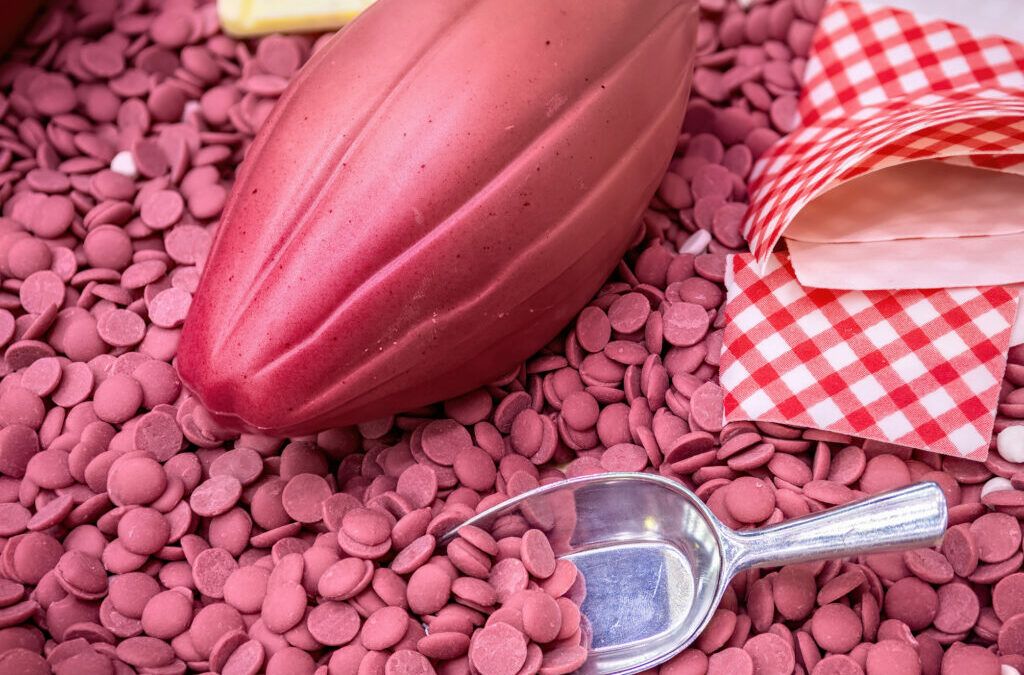==================
Affiliate Statement
Best Baking Tips is supported by our audience. When you purchase through one of our links, we may earn a small affiliate commission. As an Amazon Associate I earn from qualifying purchases. Your cost is not affected.
==================
The ruby chocolate (fourth chocolate) has been discovered recently, and it is both citrusy and conspicuously fruity. Here is everything you want to know about this trendy chocolate, including how it is made and where to buy it!
The history of chocolate is incredibly rich and delicious. We have seen futuristic pink foods in almost every form, such as cocktails, doughnuts, cheese, and Starbucks drinks. And right when you thought this chic, cotton-candy-hued shade was old, a brand new freshly pink ruby chocolate appeared and stormed to popularity.
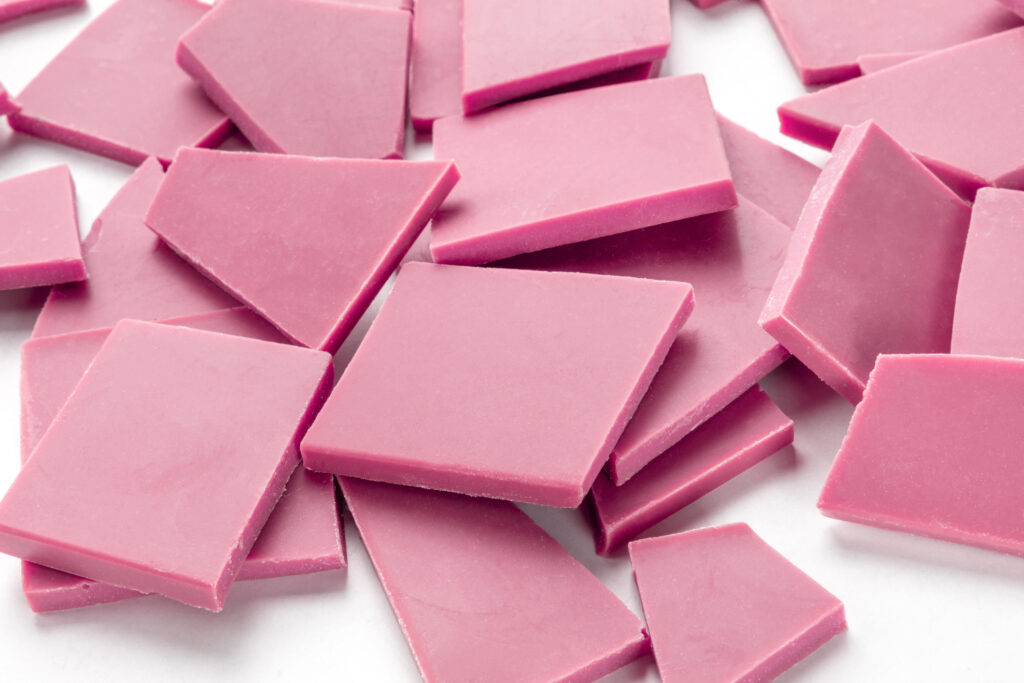
Ruby Chocolate
This newly discovered chocolate made headlines in 2018 when Nestle released a bar of limited-edition ruby chocolate in South Korea and Japan. After seeing the popularity of this chocolate, the company then introduced the Kit Kat Chocolatory Sublime Ruby flavor in the UK.
So, what is ruby chocolate? Is it any different than ol’ chocolate? Read on to know everything about this hottest pastel pink confection.
What is Ruby Chocolate?
In 2017, a team of chocolatiers at Barry Callebaut announced a new player: ruby chocolate. The chocolate is pink and has a sour flavor, which makes it unique from regular dark, white, and milk chocolates. In fact, you may find its taste smooth and milky, followed by a citrusy flavor.
According to Barry Callebaut, the chocolate is prepared from “ruby cacao beans,” which are native to Brazil, Ecuador, and Ivory Coast. Just like the grapes that are used to make fine wine, these beans are also subjective to their environment, hence cultivated in particular climates.
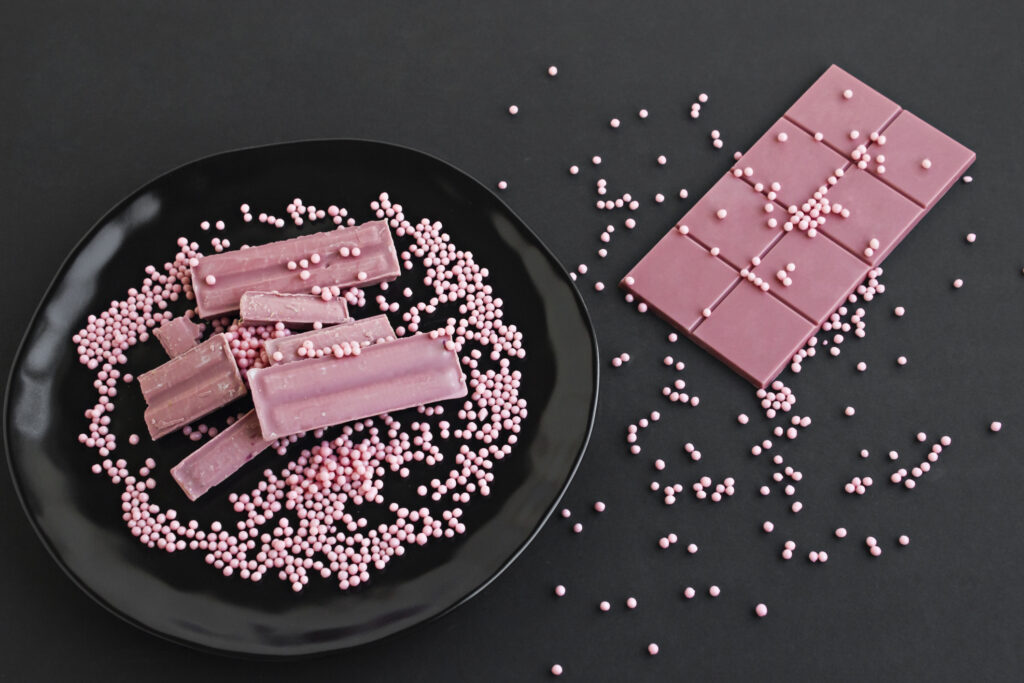
Ruby Chocolate
While the manufacturers haven’t revealed the details about the production of ruby chocolate, they have shared that the distinctive flavor and photo-worthy color of the chocolate are a result of the ruby cacao beans’ fermentation.
While ruby chocolate is not vegan, it is vegetarian-friendly. It is also processed in facilities that don’t have wheat or gluten presence, which means ruby chocolate, is gluten-free.
History of Ruby Chocolate
Although ruby chocolate first made headlines in 2018, it has been developing since 2004. During its initial stages, chocolate underwent years of research and development. In 2009, a Belgian-Swiss firm patented a cocoa material for unfermented or lightly fermented beans, turning them into vivid purple.
While the exact origin of ruby cocoa beans is still a mystery, the manufacturers assure us that they aren’t genetically modified. So, why is the availability of ruby chocolate in the market taking so long? According to the patent makes, “there’s a desire among consumers for cocoa items that have a distinctive color.”
It appears that Callebaut waited, so the market got saturated with rainbow bangles, unicorn milkshakes, and many other multi-colored products.
Taste of Ruby Chocolate
If you love eating chocolate and berries, you will surely love the taste of ruby chocolate. The company describes its flavor as “neither milky, bitter, nor sweet.” It instead tastes luscious smooth, and more like raspberry-flavored white chocolate. Other flavors of ruby chocolate include tart, yogurt, sour, and tangy.
Ingredients of Ruby Chocolate
Ingredients of ruby chocolate include:
- Cocoa butter
- Sugar
- Whole milk powder
- Non-fat dry milk
- Soy lecithin
- Unsweetened chocolate
- Natural vanilla flavor
- Citric acid
How is Ruby Chocolate Made?
The production of ruby chocolate goes through a complex and extensive beans-to-bar process:
- Since ruby chocolate is made from cacao beans, these beans are grown and harvested in Brazil, Ivory Coast, and Ecuador.
- After gathering the cocoa beans, they are fermented, sun-dried, picked, and then finally shipped to the Callebaut facility in Belgium.
- Once the cocoa beans arrive at the facility, manufacturers perform quality checks before beginning the process of coverture.
- Now, it’s time for the beans to undergo the whole bean roasting process, which involves roasting the beans in the shell. It is an effective way to preserve and develop the aromas and delicate flavors of cocoa beans.
- After the roasting process, the manufacturer separates the shells from cocoa nibs to grounding them into fine cocoa liquor. The liquor is then mixed with other ruby chocolate ingredients to form coverture dough.
- Once the mixing process is completed, the dough is then refined and conched, developing the dough into a liquid while also balancing the flavors.
- Lastly, the coverture is tempered and molded for packaging.
Difference between White Chocolate and Ruby Chocolate
Ruby chocolate is more acidic than any other chocolate due to its flavor complexity. Its high pH levels make ruby chocolate even more sensitive to crucial factors like temperature, water, oxygen, light, etc., which can affect the flavor of traditional chocolate.
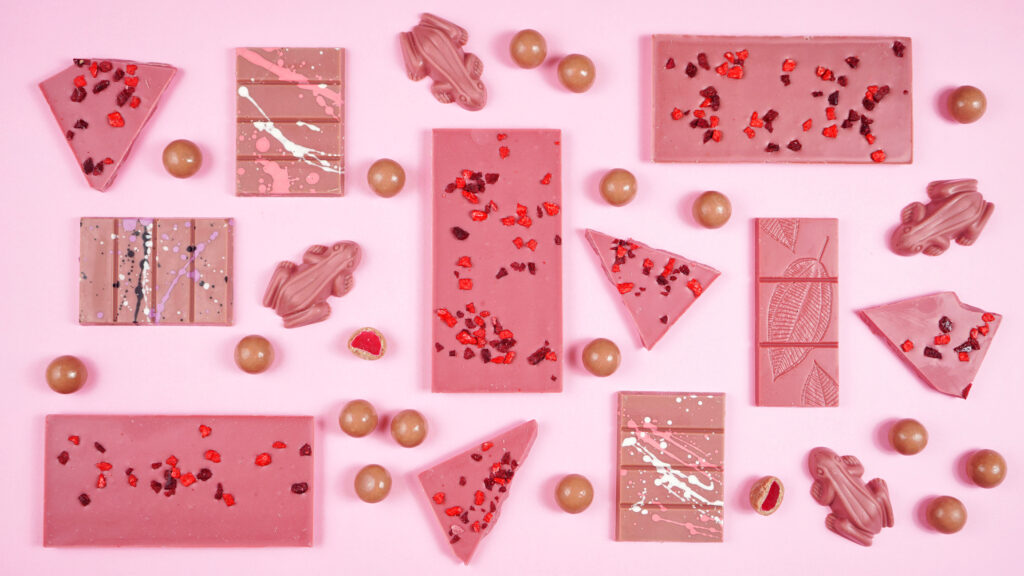
Ruby Chocolate
Moreover, blending with ingredients, high temperatures, and overmanipulating the ruby chocolate help give it a grayish pink color. That’s why ruby chocolate is popularly used for topping and in confections.
Remember that according to the FDA standards, ruby chocolate is technically not defined as chocolate in the United States. The Food and Drug Administration follows a code of federal regulations for determining food categories based on the ingredients. It also includes the maximum and minimum amount and the percentage of specific components. While ruby chocolate has all the necessary ingredients to match the FDA’s chocolate criteria, it doesn’t contain the correct ratios.
For instance, it has a large percentage of unsweetened chocolate to be white chocolate, and a lower unsweetened chocolate percentage to be milk chocolate.
Nutritional Benefits of Ruby Chocolate
Since the primary ingredient of ruby chocolate is cocoa beans, it may contain flavanols (phytonutrients). These phytonutrients are natural compounds and offer many health benefits. Some nutritional benefits of chocolate include:
- Stearic acid (saturated fat) may help regularize cholesterol levels.
- Dark chocolate can act as an antioxidant because it contains chocolate liquor and has more flavanols than milk chocolate.
However, while these are a few well-known benefits of chocolates, more research is needed to verify the same perks of ruby chocolate.
What to Pair with Ruby Chocolate?
Since the taste of ruby chocolate is so distinctive yet universal, you can pair a variety of ingredients ranging from traditional flavors like different types of vanilla to surprising flavors like tropical fruits or global cheeses.
A few ingredient pairing ideas that you can try for ruby chocolate include:
|
How to Store Ruby Chocolate?
Keep in mind that chocolates are very sensitive to certain factors, such as humidity, light, and air. They can soak up smells nearby. So, the best way to avoid such mishaps you should use an air-tight, not see-through container or jar to store ruby chocolate.
Moreover, it is also essential to keep ruby chocolate in the dark, cool corner away from light. Additionally, avoid storing your chocolate in the refrigerator to preserve its flavor.
Ruby Chocolate Truffles
Ruby chocolate small batch of truffles is one of my favorite recipes. It is so easy and only requires three ingredients to make a batch of delicious truffles. While the filling is a creamy ganache made from cream and ruby, the crisp dark chocolate coating is a bit bittersweet. The recipe is especially an ideal homemade treat for mother’s day or Valentine’s Day.
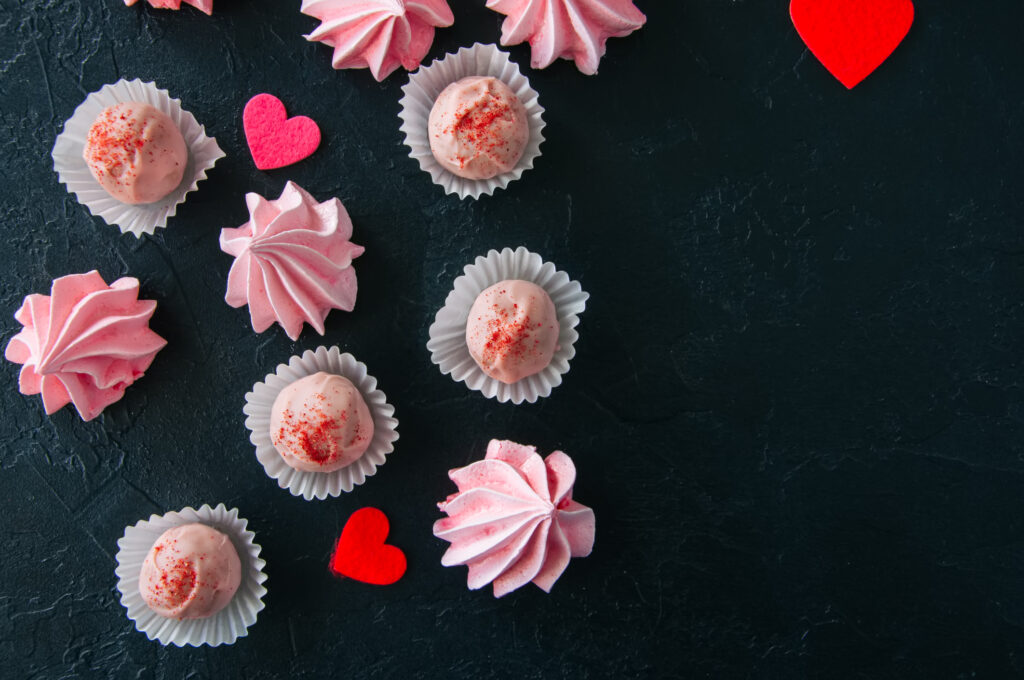
Ruby Chocolate Truffles
A few points that make ruby chocolate truffles one of my favorite recipes include:
- The recipe needs just three ingredients and only a few minutes to make delicious, yummy truffles.
- Sometimes all we want is a small taste of something sweet. With these ruby chocolate truffles, you can make a small batch of truffles that you can share with your family and friends.
- I love to prepare homemade truffles for my family on special occasions. The recipe is also a perfect choice for a romantic date night.
Ingredients
Ingredients that you will need to make ruby chocolate truffles include:
- Ruby Chocolate: Its fruity flavor and natural pink color are beautiful and delicious for truffles.
- Heavy Whipping Cream: Avoid using table cream, light cream, or half and half. Instead, use heavy whipping cream that is perfect for making chocolate ganache.
- Dark Chocolate: Lastly, you will need dark or semi-sweet chocolate to balance the fruity flavor and sweetness of ruby chocolate.
Steps
- Firstly, chop and scrape ruby chocolate into a bowl.
- Use a small saucepan to warm the cream until it simmers around the edges.
- Pour the hot cream over the chocolate and then stir into a ganache.
- Now, it’s time to cover the ganache and refrigerate it for 7-10 hours at least. You can also keep it overnight until it becomes firm enough for scooping.
- Scoop ruby chocolate into balls, place them on wax paper and freeze them for an hour or so.
- Now, melt the dark or semi-sweet chocolate in a microwave or a boiler until it becomes smooth.
- Dip the chilled, scoop balls of ruby chocolate in the melted chocolate and place them on the wax paper.
- Lastly, let these balls sit until chocolate hardens.
Here is the recipe in printable form.
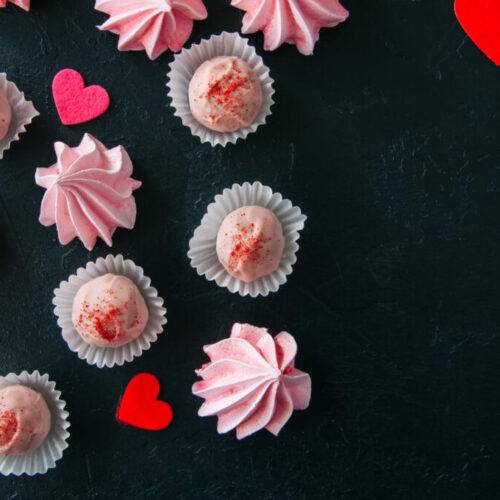
Ruby Chocolate Truffles
Ingredients
- Ruby Chocolate
- Heavy Whipping Cream
- Dark Chocolate
Instructions
- Chop the Ruby Chocolate and add to a bowl
- In a small saucepan, warm the cream just until it begins to simmer around the edges.
- Pour the hot cream over the chocolate. Stir into a ganache.
- Cover and refrigerate for 7 to 10 hours or overnight. It needs to reach a consistency that allows you to easily scoop it.
- Scoop into balls and place on wax paper.
- Freeze for an hour.
- Melt the dark chocolate in a double boiler until it reaches a smooth consistence.
- Dip the chilled balls of ruby chocolate into the melted chocolate. Place each on the wax paper as they are coated.
- Let the balls sit in a cool location until hardened.
- Enjoy!
Are you ready to try Ruby Chocolate?
Despite having no coloring, added flavor, or added berries, ruby chocolate still tastes amazingly fruity. It boasts a berry-like sweet flavor with a bit of tart after-note. The fourth-type chocolate is recognized around the world as one of the hottest food trends by food experts, media, and research agencies.
Have you tried Ruby Chocolate? What did you think of it?

